Sintering furnace atmosphere control and optimisation
It was therefore encouraging that the programme of MPIF’s PowderMet 2011 conference, held in San Francisco on 18-21 May, contained a session that focused on sintering furnace control and optimisation. Dr David Whittaker reviews two papers from this session for ipmd.net.
Two papers in this session considered the issue of atmosphere control in a continuous sintering furnace aimed at complementary objectives – to deliver sintered products of consistent quality and to maximise the service life of the mesh belt used to transport the products through the furnace.
Techniques and tips to optimise control and stabilise the atmospheres inside a continuous sintering furnace
In a paper, submitted in collaboration with his Air Products and Chemicals Inc. co-authors, John Dwyer and Zbigniew Zurecki, Tom Phillips provided a very useful guide on techniques and tips for the optimisation and control of the atmosphere inside a continuous furnace.
The paper firstly addressed the issue of atmosphere zoning. The primary function of the atmosphere varies from zone to zone – in the pre-heat zone, delubrication requires an oxidising atmosphere; in the high heat zone, a reducing atmosphere is needed to reduce the surface oxides on the powder particles and, in the cooling zones, the atmosphere must prevent oxidation and maximise cooling rates. For most continuous belt furnaces, an ideal atmosphere distribution consists of 20% wet or dry nitrogen introduced into the pre-heat zone, 60% nitrogen + hydrogen into the hot zone and 20% dry nitrogen into the cooling zone. This type of zoned atmosphere helps to minimise total gas flows and concentrates the hydrogen where it is most needed. A schematic for such a system is shown in Fig.1.

Fig. 1 A typical zoned nitrogen-hydrogen atmosphere system (As presented by Tom Phillips, Air Products and Chemicals Inc., USA, at PowderMet2011. Courtesy MPIF)
Next, the use of nitrogen gas curtains to prevent the entry of air at the ends of the furnace was described. A properly designed gas curtain that produces a transverse laminar flow across the width of the furnace will act as a physical barrier to air ingress while allowing parts to pass through without interference. A suitable design uses a rotatable nitrogen gas injector (Fig. 2).
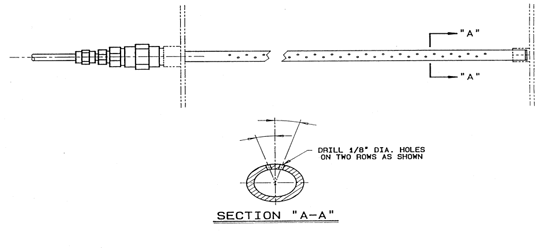
Fig. 2 A design of a rotatable gas injection tube (As presented by Tom Phillips, Air Products and Chemicals Inc., USA, at PowderMet2011. Courtesy MPIF)
A barrier to the entry of air at the exit end can also be provided by the use of fibre curtains. Curtains made of multiple rows of thin strands in a mop-like arrangement reduce heat loss and minimise oxygen infiltration and allow the parts to exit the furnace freely. The advantage of using a flexible curtain is that the fibres hug the parts tightly and do not create a visible opening. A physical barrier to the escape of gases at the exit end of the furnace helps to promote the required atmosphere flow towards the front end; typically, 80% of the gas flow should be counter to the travel direction of the parts maximising interaction of the reducing atmosphere with the parts.
It is not practical to use a fibre curtain at the front end of the furnace because of the high temperatures induced by the burning of hydrogen and lubricant vapours. Instead, the use of a flame curtain has proved to be effective here. A particularly effective design is to attach the flame curtain to the bottom of the door and allow the flame to shoot down, creating a vertical plane that covers the full cross-section of the front end.
Returning to the theme that the atmosphere is not being asked to do the same job throughout the entire furnace, the concept of interactive atmosphere control was then discussed. Any oxygen present in the furnace atmosphere is in equilibrium with hydrogen according to the reversible reaction:
2H2O < —— > 2H2 + O2
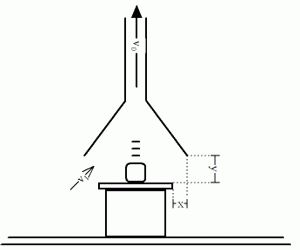
Fig. 3 A robust design of exhaust hood (As presented
by Tom Phillips, Air Products and Chemicals Inc., USA,
at PowderMet2011. Courtesy MPIF)
As the equilibrium constant for this reaction is known across a wide temperature range, a zirconia-based oxygen probe can be used for furnace atmosphere compositional control. A popular control algorithm is to adjust the flow rate of hydrogen and/or the oxidising component based on the measured oxidising/reducing potential in order to maintain the required reducing or oxidising potential in each zone of the furnace.
Finally, the design of exhaust hoods was considered. Often, the hoods at the ends of the furnace are extended down as a continuous part of the furnace muffle. This type of design can produce problems in maintaining a stable atmosphere because any up or down draft will cause a shift in the atmosphere profile within the furnace. More robust designs separate the hoods from the furnace muffle so that some air from the room goes up the vent along with the atmosphere. This type of separated hood (Fig. 3) has less pulling effect on the atmosphere inside the furnace.
Service-life extension of stainless steel wire-mesh belts for sintering furnaces
The second paper, from Anna Wehr-Aukland and Donald Bowe (Air Products and Chemicals Inc., USA) and Anthony Zaffuto and Jeremy Gabler (Metaltech Inc., USA), tackled an issue that has a significant influence on sintering process costs – degradation of the mesh belt during service.
A typical mesh belt material, AISI Type 314 stainless steel, is nominally protected from the corrosive effect of the atmosphere by a uniform surface layer of chromium oxide. However, in the high heat zone of a sintering furnace operating with a nitrogen-hydrogen atmosphere, the reducing environment destroys this oxide scale. The belt is then re-oxidised in the lower temperature, more oxidising cooling zone. The belt is therefore subject to cyclic oxidation and reduction during service. This leads to chromium depletion in the surface layers and reduced resistance to internal oxidation, carburisation and nitridation.

Fig. 4 Oxidation-reduction diagram for Fe-23Cr-19Ni and pure iron under a partial pressure of hydrogen equal to 0.06 atm (As presented by Anna Wehr-Aukland, Air Products and Chemicals Inc., USA, at PowderMet2011. Courtesy MPIF)
However, it has been observed that the reduction of the surface oxide can be prevented by increasing the moisture content (and therefore the dew point) of the atmosphere in the hot zone. The trick here is to find a dew point that is oxidising to the stainless steel belt but reducing to the oxide films of the powder particles in the PM part. The section of the Ellingham diagram, presented as Fig. 4, shows that this is a feasible proposition.
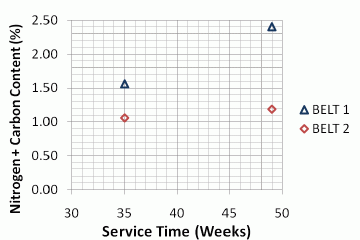
Fig. 5 Average combined concentrations of carbon and
nitrogen (in wt %) in the two belts (As presented by
Anna Wehr-Aukland, Air Products and Chemicals Inc.,
USA, at PowderMet2011. Courtesy MPIF)
A humidification system has therefore been newly developed in order to create this required increase in dew-point. The degradation characteristics of nominally identical mesh belt materials have been monitored in two furnaces operating at a hot zone temperature of 1130°C. One furnace had a “standard” nitrogen-hydrogen atmosphere with a dew-point in the high heating zone of -51°C; the second furnace, employing the humidification system, had a dew-point in the range -40 to -37°C.
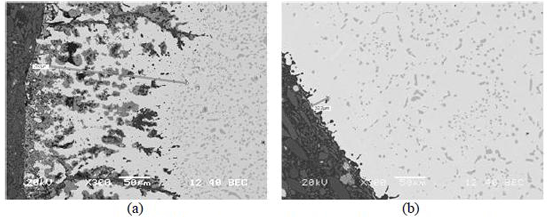
Fig. 6 Subsurface oxidation in belt 1 (a) and belt 2 (b) (As presented by Anna Wehr-Aukland, Air Products and Chemicals Inc., USA, at PowderMet2011. Courtesy MPIF)
It was found that the humidified atmosphere reduced the adverse degradation effects. Improved protection resulted in a lower rate of nitridation (Fig. 5), which delayed embrittlement, as well as a decreased rate of chromium depletion and reduced internal oxidation (Fig. 6), which postponed loss of strength.
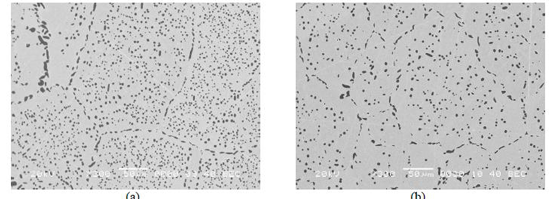
Fig. 7 Belt microstructures after 35 weeks in service in standard atmosphere (a) and modified atmosphere (b) (As presented by Anna Wehr-Aukland, Air Products and Chemicals Inc., USA, at PowderMet2011. Courtesy MPIF)
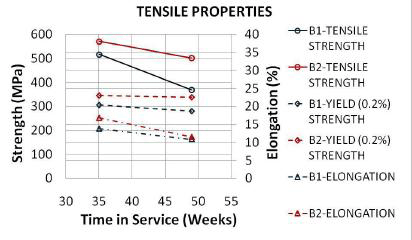
Fig. 8 Tensile properties of cross-rods removed from belts B1 (standard atmosphere) and B2 (modified atmosphere) after 35 and 49 weeks in service (As presented by Anna Wehr-Aukland, Air Products and Chemicals Inc., USA, at PowderMet2011. Courtesy MPIF)
The superior protection of the belt operated in the modified atmosphere affected the concentration and size of carbonitride and nitride particles and the length of continuous chains of such particles on grain boundaries and delayed degradation (Fig. 7). Assuming that tensile strength is the main factor determining service life and using 36.5 weeks as the reference point, the humidified atmosphere was capable of extending life by at least 34% (Fig. 8).
Routine quality control tests on the sintered parts have not revealed any problems related to the change in furnace atmosphere.
Author: Dr David Whittaker is a consultant to the Powder Metallurgy and associated industries. Contact +44 1902 338498 email: [email protected]
News | Articles | Market reviews | Search directory | Subscribe to e-newsletter





